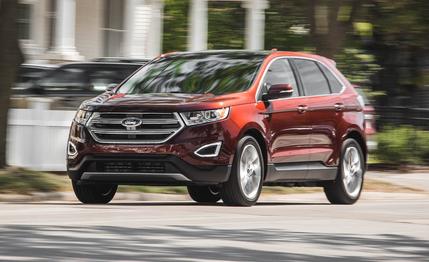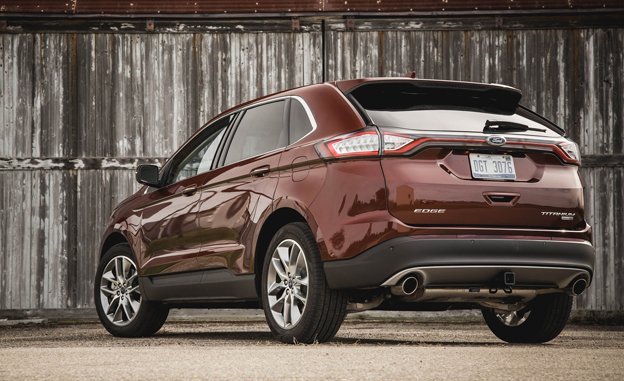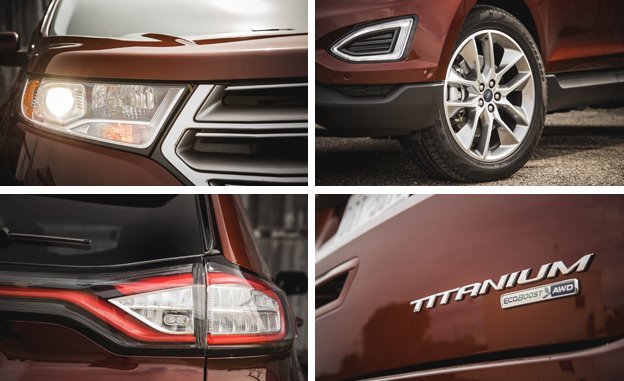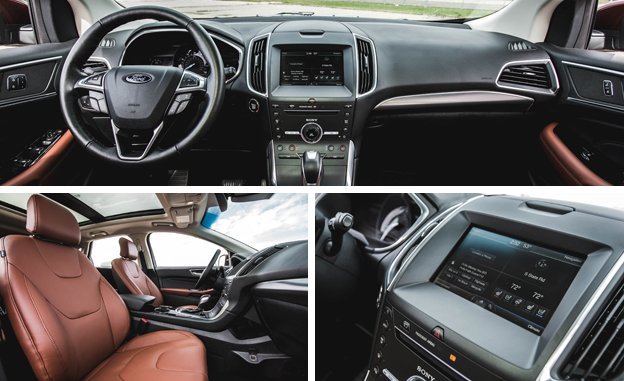
 Instrumented Test
Instrumented Test
Three times now we’ve gone to the test track with one of Ford’s newest Edge crossovers, each time with a different engine driving all four wheels. And each time, the sticker price was a little over $45,000. The $45,380 Edge Sport we tested put the money under the hood and the emphasis on performance with the 315-hp 2.7-liter EcoBoost V-6. A second example with the naturally aspirated 280-hp 3.5-liter V-6 tilted toward the luxury end of the scale in Titanium trim and wore a price tag of $45,045.
The subject of this third test is the model with the 2.0-liter four-cylinder EcoBoost engine, which was revamped for 2015 and reassigned as the base engine. Dearborn asked a $995 premium for the earlier version of this engine in the first-generation Edge. That was back when gasoline was more costly, though, and automakers figured people would gladly pay more for every increment of EPA-rated fuel economy. Today, you can get the revised version (quieter, even more efficient, and with five more horsepower for a total of 245) with all-wheel drive in an Edge SE for less than $31,000. The example Ford provided for our test, however, showed up as a leather-trimmed Titanium with an MSRP just $30 shy of the 3.5-liter Edge tested earlier.


Dearborn’s message seems to be that a well-equipped Edge is going to set you back $45,000, so where would you prefer the money be spent? The upcharge for the 3.5-liter is only $425; on this car, that was set aside in favor of the $395 Bronze Fire paint, which is one of the prettiest factory paint jobs we’ve seen on a non-luxury-brand vehicle. Otherwise, it had the same equipment as the V-6 Titanium, the only other big distinction on the window label being that the EcoBoost gets better fuel-economy ratings (20/28 mpg), beating the V-6 by 3 mpg both in the city and on the highway.
The 35-hp gap between the EcoBoost four-cylinder and the 3.5-liter V-6 doesn’t loom large considering that the smaller turbo engine has a 25 lb-ft torque advantage that also peaks 1000-rpm lower on the tach. At the track, the difference is that the four requires 0.6-second longer to reach 60 mph, taking 8.3 seconds. For comparison, Kia’s lighter, slightly less roomy Sorento with a turbo 2.0-liter managed 8.0 seconds flat.
In the quarter-mile, the difference between this EcoBoost and Ford’s V-6 shrinks to only 0.1 second and 3 mph. The four delivers slightly better 50-to-70-mph passing acceleration (5.5 seconds versus 5.8) but takes a little longer than the V-6 to get from 30 to 50 mph. Both are mated to a six-speed automatic (but with different gearing), which can be sluggish on downshifts even if the driver commands them through the standard paddles. The transmission did seem to respond a little better to this car’s beefier torque output than it did with the six.
Neither gets anywhere near the Sport’s acceleration performance (5.6 seconds to 60 mph), but this 2.0-liter example suggests that the mediocre performance of the 3.5-liter model in cornering and braking was an anomaly. With the same tires on the same-size wheels (20-inchers, a $995 option over the standard 19s), this one stopped from 70 mph in 175 feet and cornered at 0.81 g, both numbers much closer to the Sport’s (176 feet and 0.83 g) than the earlier Titanium could manage (187 feet and 0.78 g). In routine driving, it’s comfortable and agile enough, without any real vices but no particular eagerness, either.


Given that Ford emphasizes refinement and quiet operation as engineering goals both for the new-generation Edge in general and for the revisions to the 2.0-liter, we took a close look at the sound-meter readings. The four-cylinder model generates less noise at idle (40 dB where the V-6 makes 44) and at wide-open throttle (71 dB rather than 73). The naturally aspirated six, though, was quieter by 4 dB at a 70-mph highway cruise. All three tested Edges confirm the subjective impression that it’s delivering a quieter all-around driving experience than a Jeep Grand Cherokee with the Pentastar V-6, although we should note that FCA has announced revisions to its engine for 2016 and claims improved NVH. The more directly comparable Sorento 2.0T was quieter at idle, louder at full throttle, and dead even at a steady 70 mph.
All the differences here are small: Gaining the half-second to 60 mph costs only a few hundred bucks, which you could save by settling for one of the more ordinary paint jobs, but it doesn’t buy any around-town quiet. The six-cylinder Edge Titanium returned 18 mpg with our drivers while the Sport got 16 mpg. This four got 21 mpg with some of us drivers using the auto stop-start feature and others turning it off. It was noticeable, of course, but not objectionable in operation. There’s no telling where gasoline prices are going to be by the time buyers finish paying on a 60-month loan, so taking the standard engine rather than one of the thirstier upgrades could be smarter later.
Titanium trim brings a lot of luxuries, and it’s available with the base engine, so there’s no argument to upgrade there, either. Our test car had the pricey Equipment Group 302A package ($5645) with navigation, blind-spot monitoring, remote start, auto-dimming exterior mirrors, heat for the steering wheel and the front and rear seats, front-seat coolers, Ford’s enhanced park assist (parallel and perpendicular, including departure from the space), a panoramic glass roof, a front camera, rain-sensing wipers, inflatable rear safety belts, etc. A buyer might save a chunk of change by selecting only a few of those options, but pay mind to the incentive programs—this car showed $945 worth ($445 “equipment group savings” and a $500 all-wheel-drive discount).


The navigation and infotainment systems did not use the latest Sync 3 system that could arrive on 2016 models. Instead, this car had the last generation of MyFord Touch. We’ve not been fans, but our earlier complaints about that system have been addressed with redundant physical buttons to supplement the glitchy voice-command and buried touch-screen menus, and we had no real issues with operating this car’s systems.
With the Class II trailer-tow package ($435) on this example, the EcoBoost four has the same 3500-pound trailer-tow rating as the V-6 model, so there’s nothing to choose there unless you’re eyeing a Sport—Ford doesn’t offer the tow package with the 2.7-liter EcoBoost, so it maxes out at 2000 pounds.
Anyone looking for entertainment at the wheel of a $45,000 Edge should nevertheless opt for the Sport. The buyer who wants the luxury version may not be of a mind-set to accept a base engine, especially one with only four cylinders, but it would be a respectable decision. At lower trim levels, though, the 2.0-liter is probably the best choice.